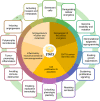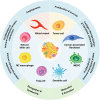STAT3 pathway in cancers: Past, present, and future
- PMID: 35356799
- PMCID: PMC8942302
- DOI: 10.1002/mco2.124
STAT3 pathway in cancers: Past, present, and future
Erratum in
-
Erratum.MedComm (2020). 2022 Apr 20;3(2):e135. doi: 10.1002/mco2.135. eCollection 2022 Jun. MedComm (2020). 2022. PMID: 35474947 Free PMC article.
Abstract
Signal transducer and activator of transcription 3 (STAT3), a member of the STAT family, discovered in the cytoplasm of almost all types of mammalian cells, plays a significant role in biological functions. The duration of STAT3 activation in normal tissues is a transient event and is strictly regulated. However, in cancer tissues, STAT3 is activated in an aberrant manner and is induced by certain cytokines. The continuous activation of STAT3 regulates the expression of downstream proteins associated with the formation, progression, and metastasis of cancers. Thus, elucidating the mechanisms of STAT3 regulation and designing inhibitors targeting the STAT3 pathway are considered promising strategies for cancer treatment. This review aims to introduce the history, research advances, and prospects concerning the STAT3 pathway in cancer. We review the mechanisms of STAT3 pathway regulation and the consequent cancer hallmarks associated with tumor biology that are induced by the STAT3 pathway. Moreover, we summarize the emerging development of inhibitors that target the STAT3 pathway and novel drug delivery systems for delivering these inhibitors. The barriers against targeting the STAT3 pathway, the focus of future research on promising targets in the STAT3 pathway, and our perspective on the overall utility of STAT3 pathway inhibitors in cancer treatment are also discussed.
Keywords: STAT3; STAT3 pathway inhibitors; cancer hallmarks; cancer treatment.
© 2022 The Authors. MedComm published by Sichuan International Medical Exchange & Promotion Association (SCIMEA) and John Wiley & Sons Australia, Ltd.
Conflict of interest statement
The authors have no conflict of interest to declare.
Figures






Similar articles
-
Nanoparticle-Mediated Delivery of STAT3 Inhibitors in the Treatment of Lung Cancer.Pharmaceutics. 2022 Dec 13;14(12):2787. doi: 10.3390/pharmaceutics14122787. Pharmaceutics. 2022. PMID: 36559280 Free PMC article. Review.
-
STAT3 Pathway in Gastric Cancer: Signaling, Therapeutic Targeting and Future Prospects.Biology (Basel). 2020 Jun 12;9(6):126. doi: 10.3390/biology9060126. Biology (Basel). 2020. PMID: 32545648 Free PMC article. Review.
-
Biological Hallmarks and Emerging Strategies to Target STAT3 Signaling in Multiple Myeloma.Cells. 2022 Mar 10;11(6):941. doi: 10.3390/cells11060941. Cells. 2022. PMID: 35326392 Free PMC article. Review.
-
Critical analysis of the potential for targeting STAT3 in human malignancy.Onco Targets Ther. 2013 Jul 30;6:999-1010. doi: 10.2147/OTT.S47903. Print 2013. Onco Targets Ther. 2013. PMID: 23935373 Free PMC article.
-
STAT3 and its targeting inhibitors in osteosarcoma.Cell Prolif. 2021 Feb;54(2):e12974. doi: 10.1111/cpr.12974. Epub 2020 Dec 31. Cell Prolif. 2021. PMID: 33382511 Free PMC article. Review.
Cited by
-
Sorafenib Chemosensitization by Caryophyllane Sesquiterpenes in Liver, Biliary, and Pancreatic Cancer Cells: The Role of STAT3/ABC Transporter Axis.Pharmaceutics. 2022 Jun 14;14(6):1264. doi: 10.3390/pharmaceutics14061264. Pharmaceutics. 2022. PMID: 35745837 Free PMC article.
-
Inhibition of ASAP1 Modulates the Tumor Immune Microenvironment and Suppresses Lung Cancer Metastasis via the p-STAT3 Signaling Pathway.Cell Biochem Biophys. 2024 Sep;82(3):2387-2399. doi: 10.1007/s12013-024-01349-y. Epub 2024 Jun 14. Cell Biochem Biophys. 2024. PMID: 38874840
-
B cell-intrinsic STAT3-mediated support of latency and interferon suppression during murine gammaherpesvirus 68 infection revealed through an in vivo competition model.bioRxiv [Preprint]. 2023 Mar 22:2023.03.22.533727. doi: 10.1101/2023.03.22.533727. bioRxiv. 2023. PMID: 36993230 Free PMC article. Preprint.
-
ITM2A inhibits the progression of bladder cancer by downregulating the phosphorylation of STAT3.Am J Cancer Res. 2024 May 15;14(5):2202-2215. doi: 10.62347/KHCC9690. eCollection 2024. Am J Cancer Res. 2024. PMID: 38859860 Free PMC article.
-
Exploring glycolytic enzymes in disease: potential biomarkers and therapeutic targets in neurodegeneration, cancer and parasitic infections.Open Biol. 2025 Feb;15(2):240239. doi: 10.1098/rsob.240239. Epub 2025 Feb 5. Open Biol. 2025. PMID: 39904372 Free PMC article. Review.
References
-
- Sung H, Ferlay J, Siegel RL, et al. Global cancer statistics 2020: gLOBOCAN estimates of incidence and mortality worldwide for 36 cancers in 185 countries. CA Cancer J Clin. 2021;71(3):209‐249. - PubMed
-
- World Health Organization . World Health Statistics 2021: Monitoring Health for the SDGs, Sustainable Development Goals. World Health Organization; 2021.
Publication types
LinkOut - more resources
Full Text Sources
Miscellaneous
